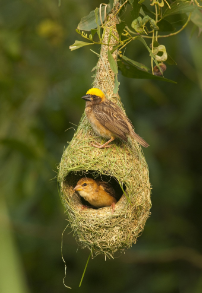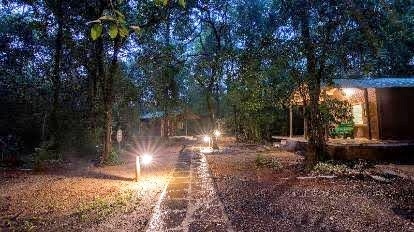Bird Watching in Manipal.
While walking around the paddy fields looking for the different varieties of birds like Ibis and the Kingfisher, I spotted a beautiful woven nest hanging from the Palmyra tree above my head. I was immediately captivated by the nest and wanted to know everything about how such a thing of beauty could be woven so high in the air and how it managed to stay up in the strong winds and rains.
I had recently started bird watching as a hobby and wanted to know about which bird weaved the nest, how many eggs were laid and when was the nesting season, what was the lifespan of the bird, what their social organization was like. I observed closely and saw a small sparrow like yellow bird flying around the nest and got to know that it was the Baya Weaver Bird.
The Weaver Bird turned out to be an excellent architect and I was really amazed at the skill of this bird in making an eco-friendly, organic and bio degradable house for its mate and children. Not many humans take the initiative to build ingeniously designed, cosy homes just to woo a mate and to house the to-be-born children, but our tiny Baya weaver bird does it all the time. Since there were many such nests hanging I assumed that it was a large joint family which hung out together and subsequently referred to my books and read up a lot more about this unique bird.
I found out that the Baya weavers are social and gregarious birds. They forage in flocks for seeds, both on the plants and on the ground. The farmers often destroy their nest as they eat the food grains, small insects, moth, spider and seeds. The nests are often made in such a way so as to escape the predators like snakes, crows and squirrels and the special design of the nest keeps the eggs protected and doesn’t allow easy access to the predators.
They nest in colonies, close to sources of food, nesting material and water. Baya weavers are extremely talented birds. They win the hearts of any observer with their nest-weaving craft. It is really worth observing them weave the nest as the activity is hardwired into the male bird as a nuptial activity. The nest building is a very labour and skill intensive task and may take up to twenty days, the male bird is therefore very opportunistic and aware of his talent. The songbird makes a series of chatter and whistles to attract a potential mate. After the Nest Advertisement display and mutual antagonism, they are accepted by females.
Once a female likes his nest, he courts her and completes the nest. After accepting a nest and its builder, the female would not reconsider her decision because she gets invested in the process. Alongside the male, she would hunker down to some nest-weaving herself, which makes the completed nest “theirs”, not “his” alone.
She modifies the nest a little as per her choice and lays eggs. Meanwhile, the male weaves another nest and starts persuading other females. If the breeding season is not over, he may also persuade a third female. Thus, baya weaver birds show polygynous mating behaviour .Their biological clock ticks to the monsoons, which is when it breeds and raises families.
So my thoughts on Baya weaver bird is that it is an intelligent bird which propagates or procreates in a highly intelligent manner, these birds are clearly polygamous and do not mate for life or stick to one partner which gives them probably more genetic diversity and chances of the species surviving extinction a better chance. The female birds also mate with others and keep moving on every season in their small life span of fifteen years. I personally find this very interesting and bird watching is indeed very thought provoking.
Despite everything the problem of habitat and non-availability of food grains has led to the decline of these birds. The artistic nests of weaver birds were a common sight all around about a decade back but there has been a sudden decline in their numbers as palm and date tress were chopped. These birds generally use long strips of paddy leaves, rough grass and long strips torn from palm fronds to make nests. Due to rapid urbanisation the raw material for building nest reduced, the increasing use of microwave towers by mobile phone operators was the main reason behind the vanishing of small birds from urban habitations. Moreover, these birds live on small insects and grains. Rampant use of pesticides like DDT has poisoned the food of the birds leading to their gradual extinction. Therefore we have to spray almost double the amount of pesticides and in turn end up consuming the pesticides with our food. When avian species are lost, their particular functions and benefits disappear, too.
One thing which I learnt from Bird Watching is that the food cycle needs to be kept intact as the ecological balance depends on the sustenance of the whole eco system. Birds are environmentally friendly exterminators as they are voracious predators of pests. China learned a valuable lesson about the ill effects of man conquering nature during the "Great Leap Forward" , when sparrows were exterminated leading to famine and death as locust and other pests wiped out the crops.
Birds help spread nutrients through their poop which is critical in wetland and coastal regions as not only seeds are dispersed but also the soil gets fertilized.





Comments
Post a Comment